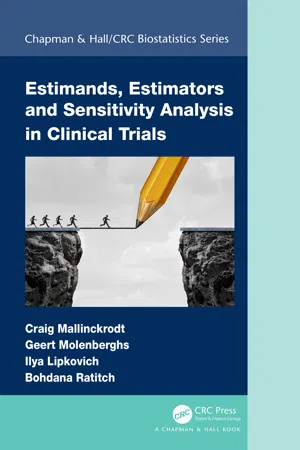
Estimands, Estimators and Sensitivity Analysis in Clinical Trials
- 318 pages
- English
- ePUB (mobile friendly)
- Available on iOS & Android
Estimands, Estimators and Sensitivity Analysis in Clinical Trials
About this book
The concepts of estimands, analyses (estimators), and sensitivity are interrelated. Therefore, great need exists for an integrated approach to these topics. This book acts as a practical guide to developing and implementing statistical analysis plans by explaining fundamental concepts using accessible language, providing technical details, real-world examples, and SAS and R code to implement analyses. The updated ICH guideline raises new analytic and cross-functional challenges for statisticians. Gaps between different communities have come to surface, such as between causal inference and clinical trialists, as well as among clinicians, statisticians, and regulators when it comes to communicating decision-making objectives, assumptions, and interpretations of evidence.
This book lays out a path toward bridging some of these gaps. It offers
A common language and unifying framework along with the technical details and practical guidance to help statisticians meet the challenges
A thorough treatment of intercurrent events (ICEs), i.e., postrandomization events that confound interpretation of outcomes and five strategies for ICEs in ICH E9 (R1)
Details on how estimands, integrated into a principled study development process, lay a foundation for coherent specification of trial design, conduct, and analysis needed to overcome the issues caused by ICEs:
A perspective on the role of the intention-to-treat principle
Examples and case studies from various areas
Example code in SAS and R
A connection with causal inference
Implications and methods for analysis of longitudinal trials with missing data
Together, the authors have offered the readers their ample expertise in clinical trial design and analysis, from an industrial and academic perspective.
Frequently asked questions
- Essential is ideal for learners and professionals who enjoy exploring a wide range of subjects. Access the Essential Library with 800,000+ trusted titles and best-sellers across business, personal growth, and the humanities. Includes unlimited reading time and Standard Read Aloud voice.
- Complete: Perfect for advanced learners and researchers needing full, unrestricted access. Unlock 1.4M+ books across hundreds of subjects, including academic and specialized titles. The Complete Plan also includes advanced features like Premium Read Aloud and Research Assistant.
Please note we cannot support devices running on iOS 13 and Android 7 or earlier. Learn more about using the app.
Information
Section IV
Technical Details on Selected Analyses
17
Example Data
17.1 Introduction
17.2 Details of Example Data Set
17.2.1 Complete Data Set
Table of contents
- Cover
- Half Title
- Series Page
- Title Page
- Copyright Page
- Table of Contents
- List of Figures
- List of Tables
- List of Code Fragments
- Preface
- Acknowledgments
- Authors
- Section I Setting the Stage
- Section II Estimands
- Section III Estimators and Sensitivity
- Section IV Technical Details on Selected Analyses
- Section V Case Studies: Detailed Analytic Examples
- References
- Glossary
- Index